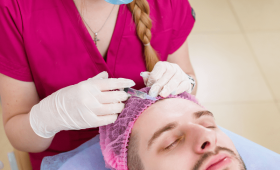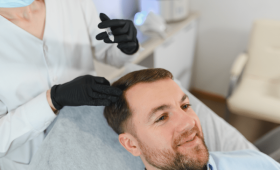I. Introduction: A New Hair Restoration Paradigm for Women
Hair transplantation for women has long remained a matter of uncertainty, especially for those who do not wish to shave their entire head. This concern has led many women seeking hair loss treatment to postpone the process or turn to alternative solutions. However, thanks to advancements in hair transplant technology, it is now possible to give a clear and positive answer to this question: Yes, it is possible for women to undergo a hair transplant without shaving their hair. Known as unshaven hair transplantation, this modern approach is a less invasive option compared to traditional methods, specifically developed for women who want to preserve their existing hair length and style.
This method offers a significant solution for professional women who are constantly in the public eye and wish to maintain their image. The “secrecy” concern that arises when the hair needs to be fully shaved is largely eliminated with unshaven techniques. The preservation of the existing hairstyle after the operation and the possibility of a quick return to work or social life make this method an ideal alternative for women experiencing male-pattern hair loss. This report is not merely an endorsement but aims to prepare patients with full awareness by delving into the medical mechanisms behind these advanced techniques, the suitability criteria, potential challenges, and factors affecting success.
II. The Science Behind Discretion: Unshaven Hair Transplant Techniques
Unshaven hair transplantation differs fundamentally from traditional hair transplant procedures. Conventional approaches require the entire donor and recipient areas to be completely shaved to ensure maximum visibility and accessibility. In contrast, unshaven methods adopt a more meticulous approach. In these techniques, the length of the existing hair is strategically used to conceal the signs of the operation. This necessitates a more delicate and careful extraction of hair follicles from the donor area, making the surgical process more complex and requiring greater expertise. These procedures are typically performed using two main methods: FUE and DHI.
2.1. Comparative Analysis of the Main Techniques: Unshaven FUE and DHI
The primary methods used in unshaven hair transplantation are called FUE (Follicular Unit Extraction) and DHI (Direct Hair Implantation). Both techniques are based on the principle of extracting hair follicles one by one, but they show significant differences in terms of their application stages and results.
- Unshaven FUE (Follicular Unit Extraction): In this method, individual hair follicles are collected from the donor area with the help of a special microsurgical tool. Then, microscopic channels are opened in the recipient area using steel slits or sapphire blades, and the collected grafts are placed into these channels. In Unshaven FUE, only a small, strip-shaped portion of the donor area may be shaved. This shaved area is easily concealed by the longer hair above it, so the procedure is not visible.
- DHI (Direct Hair Implantation): DHI is actually a more advanced variation of the FUE method and stands out as an ideal solution for unshaven hair transplantation. This method uses a special implanter pen called the “Choi Pen.” This pen performs the extraction and implantation of the graft simultaneously in a single step. This eliminates the need for pre-made channels in the recipient area, which ensures that existing hair follicles and tissue receive minimal trauma. The DHI technique offers the ability to precisely control the angle, depth, and direction of the hair follicle, which allows for more natural and dense results, especially for hair thickening procedures common in women.
Hair loss in women typically manifests as thinning or widespread scarcity rather than a large bald area. This situation necessitates that the hair transplant procedure is generally focused on “densification.” Since the DHI technique eliminates the need for creating pre-made channels, it allows for grafts to be placed directly between the existing hairs. This feature significantly reduces the risk of damaging the local hairs that are already weakened during the procedure. Therefore, in an operation aimed at hair densification in women, the DHI method is considered a technically safer and superior option compared to FUE.
| Feature | Unshaven FUE | DHI |
| Method | Two-stage (extraction and implantation) | One-stage (simultaneous extraction and implantation) |
| Channel Opening | Channels are opened before graft implantation | Channel and implantation are done simultaneously with a special pen; no pre-channel is opened |
| Bleeding | Moderate | Very minimal |
| Swelling | Usually occurs | Very minimal |
| Graft Capacity | Limited in a single session (e.g., 2000 grafts) | Limited in a single session (e.g., 2000 grafts) |
| Ideal Application Area | Suitable for large areas, but limited in unshaven application | Ideal for thinning and densification |
| Precision | Good, but less than DHI | More control over the depth, direction, and angle of the opened channel |
| Recovery Speed | Fast, but slightly longer than DHI | Shorter |
| Cost | More expensive than shaved FUE | Generally more expensive than FUE |
III. Candidacy: A Personal Evaluation
Despite the advantages it offers, unshaven hair transplantation is not a suitable method for everyone. It is vital to have a comprehensive consultation with an experienced doctor before deciding if a person is a good candidate for this operation. This consultation helps to balance the patient’s expectations with medical realities, ensuring a clear understanding of the potential outcomes.
3.1. Candidacy Criteria for Women and Unshaven Techniques
- Cause and Stability of Hair Loss: The most suitable candidates for unshaven hair transplantation are those experiencing hair loss due to genetic factors (androgenetic alopecia) or localized loss. Women with widespread and unstable hair loss caused by hormonal imbalances (PCOS, thyroid issues), chronic illnesses, or telogen effluvium should first treat the underlying health problems.
- Degree of Hair Loss: These techniques are suitable for individuals who do not have severe hair loss and have a low graft requirement. In situations requiring a high number of hair follicles, such as 3,000 to 5,000 grafts, a fully shaved method may be preferred to ensure the success of the operation.
- Health of the Donor Area: The success of the operation depends on the density and quality of the donor area from which the hair follicles are taken. The hair in this region is genetically resistant to shedding, which ensures that the transferred grafts will be permanent for life.
A patient’s greatest desire before undergoing a hair transplant is often to maintain the discretion of the operation and ensure that no one notices. This is an aesthetic expectation. However, sources indicate that this aesthetic desire is directly related to a medical limitation. In unshaven techniques, the number of grafts that can be harvested in a single session is limited to allow for the camouflage of the donor area. Therefore, the degree of the patient’s hair loss and the corresponding number of grafts needed become the most fundamental factors in determining whether they are suitable for an unshaven operation. A patient may wish for the unshaven method to avoid a change in their appearance, but if the number of grafts they need exceeds the capacity of this method, this wish will unfortunately not be medically possible. This situation highlights how crucial a doctor’s consultation is for understanding if the patient’s expectations are realistic and for establishing a balance between surgical capacity and personal desire.
IV. The Transformation Journey: Procedure and Recovery Process
Hair transplantation is more than a single operation; it is a comprehensive journey that includes meticulous planning and a recovery process. With unshaven techniques, this journey begins by preserving discretion.
4.1. Pre-Operative Preparation and Process
The pre-operative stage begins with a detailed evaluation. The doctor designs the hairline and analyzes the condition of the donor area. For an unshaven procedure, patients with long hair are advised to grow their hair a bit longer to make it easier to conceal the partially shaved donor area. The operation is performed under local anesthesia, which ensures the patient feels no pain or discomfort during the procedure. The procedure itself can take approximately 7-8 hours and may last longer than shaved operations, as the careful extraction and placement of each graft require high precision.
4.2. Post-Operative Recovery and Phases
- First Few Days (First 10 Days): It is normal to experience slight swelling, redness, and scabbing after the operation. Pain, which is usually minimal, can be controlled with simple painkillers. The first wash is a critical step, and it is often recommended to be performed by a professional team at the clinic to ensure proper settling of the grafts.
- The Shock Loss Phase (First 1-3 Months): This is the most concerning, yet completely natural, part of the recovery process. Due to the trauma experienced during the procedure, the upper parts of the transplanted hair follicles temporarily shed. This shedding begins between the 15th and 20th days and can last for about 2 months. This period, medically referred to as “telogen effluvium,” is associated with the hair follicles entering a resting phase. It is important for patients not to see this as a sign of failure, as the shed hair will begin to grow back in 3-4 months.
- 3-6 Months: New, fine hairs begin to grow slowly.
- 6-12 Months: The hair thickens noticeably and gains density, during which the first visible results are achieved.
- 12-18 Months: The hair fully matures, reaches its final state, and blends seamlessly with the existing hair.
| Phase | What to Expect |
| First 1-2 Days | Mild swelling, redness, and tenderness |
| First 10 Days | Scabbing in the transplanted area, wounds in the donor area |
| First 1-3 Weeks | Shedding of initial scabs, mild itching |
| First 1-3 Months | Shock loss; up to 99% of the transplanted hair may shed |
| 3-6 Months | Growth of the first “baby” hairs, accelerated healing |
| 6-12 Months | Noticeable thickening and increased density of the hair |
| 12-18 Months | Final and complete result, hair regains its natural appearance |
Patients who opt for unshaven hair transplantation desire to erase the visible signs of the operation immediately. However, sources point to a period called the “ugly duckling” phase that occurs during this process. This is a situation where the patient’s desire for discretion clashes with the temporary and aesthetically challenging reality of the recovery process. Therefore, it is of great importance for clinics to prepare patients for this psychological phase and to emphasize that this period is completely normal and temporary. Effective communication can help maintain the patient’s morale during this sensitive process.
V. Advantages and Disadvantages: A Balanced Perspective
Unshaven hair transplantation, in addition to its distinct benefits, also has some limitations that should be considered.
5.1. Aesthetic and Social Benefits (Advantages)
- Discretion: The greatest advantage of the method is that the hair remains at its existing length after the procedure, and the operation is not noticeable from the outside. This is a critical factor, especially for those who do not want to take time away from their social or professional lives.
- Quick Social Return: Patients can return to their work and social lives immediately after the operation or within a short period of 2-5 days.
- Preservation of Existing Hairstyle: Since the hair is not fully shaved, it is possible to maintain the existing hairstyle.
- Natural Appearance: Especially with precise techniques like DHI, the transplanted hair provides a natural look and flow.
5.2. Technical and Practical Limitations (Disadvantages)
- Limited Graft Count: The most significant limitation of the unshaven method is the limited number of grafts that can be harvested in a single session. This means that the method may not be suitable for those with more severe hair loss and may require multiple sessions to achieve the desired result.
- Higher Cost: Unshaven procedures are more expensive than traditional methods because they require more time and meticulousness.
- Increased Surgical Difficulty: These techniques require a more experienced surgeon, as they demand the precise extraction and placement of each individual graft.
- More Difficult Maintenance: After the operation, washing and caring for the transplanted area can be more difficult due to the presence of long hair.
VI. Minimizing Risks and Ensuring a Successful Outcome
The success of a hair transplant operation depends not only on the technique used but also on the surgeon, the clinic, and the patient’s commitment to the process.
6.1. The Importance of Professional Selection
The most critical factor determining the success of a hair transplant procedure is the selection of an experienced professional and a reliable clinic to perform the operation. Mistakes made by an inexperienced surgeon can cause a chain reaction. Situations such as incorrect planning , damage to existing healthy hair , failure to implant grafts at the correct angles , or damage to grafts during the operation can lead to undesirable outcomes. This not only results in a poor aesthetic appearance but can also leave permanent scars in the donor area. A bad experience can lead to financial loss and emotional distress, negatively affecting the patient’s psychological state. Therefore, achieving the discreet and natural look the patient expects from the operation is directly dependent on the surgeon’s expertise and competence.
6.2. Common Causes of Unsuccessful Outcomes
- Unrealistic Expectations: Patients’ expectations of achieving a density or hairline beyond the capacity of their donor hair are one of the most common causes of disappointment.
- Inadequate Post-Operative Care: Failure to follow the doctor’s instructions can lead to grafts dislodging, infections, and a disrupted healing process.
- Inappropriate Candidate Selection: Performing an operation on a patient who is not a suitable candidate for a hair transplant leads to a failed procedure. For example, patients whose hair loss has not yet stabilized or who do not have sufficient donor hair fall into this group.
- Technical Errors: Technical errors made by an inexperienced team, such as incorrect channel opening, an asymmetrical hairline, or inadequate density, can lead to failure.
VII. Complementary and Alternative Treatments
Hair transplantation is not the only option in the fight against hair loss. Non-surgical treatments like PRP (Platelet-Rich Plasma) and mesotherapy can offer supportive or alternative solutions to hair transplantation.
7.1. The Role of Non-Surgical Treatments
- PRP (Platelet-Rich Plasma) Therapy: This involves injecting plasma rich in platelets, obtained from the patient’s own blood, into the scalp. This treatment increases the vitality of existing hair follicles, repairs weakened hairs, and supports hair growth. However, it does not promote the growth of new hair in completely bald areas.
- Mesotherapy: This method involves the micro-injection of a special cocktail of vitamins, minerals, and amino acids into the scalp to nourish the hair follicles. This method increases blood circulation, reduces hair loss, and improves hair quality.
A comparison of PRP and mesotherapy with hair transplantation reveals a fundamental difference in the goals of the treatments. Hair transplantation is a surgical procedure aimed at permanently creating new hair density. On the other hand, PRP and mesotherapy are non-surgical procedures focused on improving the health of existing hair and reducing shedding. These treatments should be seen as supportive methods rather than a replacement for hair transplantation, used to prepare the scalp before the operation or to boost the strength of transplanted and existing hairs afterward. In cases of severe hair loss, PRP can be used as a supportive treatment for a hair transplant operation.
| Feature | Hair Transplantation | PRP & Mesotherapy |
| Primary Goal | To provide permanent hair density | To improve the quality and health of existing hair |
| Mechanism | Surgical transfer of hair follicles that are genetically resistant to shedding | Injection of plasma or vitamins into the scalp with a needle |
| Type of Loss | Advanced, stable hair loss | Mild-to-moderate hair loss and thinning |
| Expected Result | Growth of new, permanent hair | Strengthening of existing hair and reduced shedding |
| Permanence | Lifelong | Temporary; requires regular sessions |
| Best Use | Filling bald or severely thinned areas | Pre- or post-transplant support, or treatment for mild hair loss |
VIII. Conclusion: Making an Informed Decision
Unshaven hair transplantation for women is a realistic and effective option offered by modern medicine. This method is a valuable solution, especially for individuals who prioritize discretion and want to return to their social lives quickly. However, it should be remembered that this procedure is not suitable for every patient and will be limited in cases of severe hair loss. The success of a hair transplant depends on the harmonious relationship between the patient’s individual characteristics and the surgeon’s expertise.
This report provides a comprehensive guide to the first and most important stage of the hair transplant journey: gathering information. However, no written source can replace a personal medical evaluation. Therefore, the final and most crucial step in determining whether a person is a suitable candidate for this operation and which technique is most appropriate is to have an in-person consultation with a reliable and experienced hair transplant specialist. This consultation will allow the information gained to be applied to the individual’s specific situation, laying the groundwork for a well-informed and satisfying decision.
Unlocking Your Confidence with a Hair Transplant in Turkey: An Exclusive Offer from Cure Holiday
Have you been thinking about getting your hair back, but you’re not sure where to start? A hair transplant can be a life-changing experience, and Turkey has become the number one destination for this popular cosmetic procedure. With advanced techniques and experienced surgeons, it’s easier and more affordable than ever to restore your hair and your confidence.
At Cure Holiday, we specialize in making this journey simple, safe, and stress-free. We believe that everyone deserves to feel their best, and our all-inclusive packages are designed to give you a premium experience without the premium price tag.
Why Choose Cure Holiday?
- Experienced Doctors: Our partner clinics work with some of Turkey’s most skilled and reputable surgeons, ensuring you’re in expert hands from start to finish.
- All-Inclusive Comfort: Forget about the hassle of planning. Our packages cover everything: your flights, 5-star hotel stay, airport transfers, and even a dedicated host to guide you through every step of your treatment.
- Cutting-Edge Techniques: We offer the latest hair transplant methods, including FUE (Follicular Unit Extraction) and DHI (Direct Hair Implantation), giving you natural, permanent results with minimal scarring.
- Unbeatable Value: Thanks to Turkey’s lower operational costs, we can provide world-class quality at a fraction of the price you’d pay in the UK, USA, or Europe.
Your New Look is Closer Than You Think
Ready to take the first step toward a new you? Contact us today for a free consultation. Our team is here to answer all your questions and help you customize a plan that’s perfect for you.
Don’t let another day go by wishing for the hair you used to have. Let Cure Holiday help you get it back, with an exclusive offer you won’t find anywhere else.



